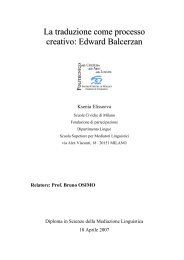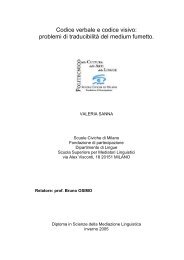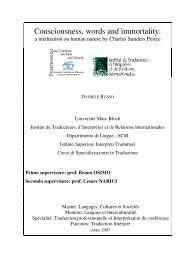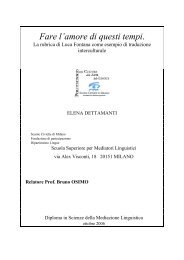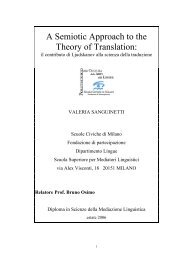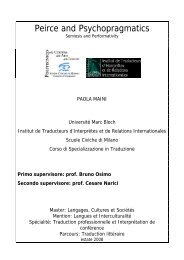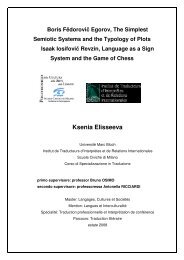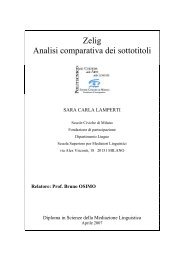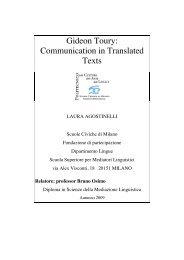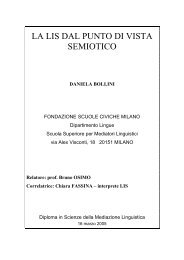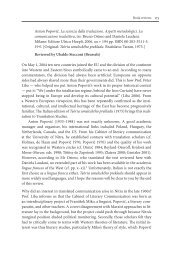Alice in Wonderland - Bruno Osimo, traduzioni, semiotica della ...
Alice in Wonderland - Bruno Osimo, traduzioni, semiotica della ...
Alice in Wonderland - Bruno Osimo, traduzioni, semiotica della ...
You also want an ePaper? Increase the reach of your titles
YUMPU automatically turns print PDFs into web optimized ePapers that Google loves.
In the real world, proper names may be non-descriptive, but they are<br />
obviously not non-<strong>in</strong>formative: If we are familiar with the culture <strong>in</strong><br />
question, a proper name can tell us whether the referent is a female or<br />
male person (<strong>Alice</strong> – Bill), maybe even about their age (some people name<br />
their new-born child after a pop star or a character of a film that happens to<br />
be en vogue) or their geographical orig<strong>in</strong> with<strong>in</strong> the same language<br />
community (e.g., surnames like McPherson or O’Connor, a first name like<br />
Pat) or from another country, a pet (there are “typical” names for dogs,<br />
cats, horses, canaries, etc., like Pussy or Fury), a place (Mount Everest), etc.<br />
Such <strong>in</strong>dicators may lead us astray <strong>in</strong> real life, but they can be assumed to<br />
be <strong>in</strong>tentional <strong>in</strong> fiction.<br />
Titles and forms of address can also be problematic <strong>in</strong> translation.<br />
The protagonist of the Spanish children’s book El muñeco de don Bepo, by<br />
Carmen Vázquez-Vigo, is don Bepo, a circus ventriloquist. In the German<br />
translation, he is called Herr Beppo. The Spanish honorific title don is<br />
always comb<strong>in</strong>ed with a first name, whereas Herr can only be used with a<br />
surname. S<strong>in</strong>ce German circus performers “typically” have Italian stage<br />
names, it would have been more adequate to translate don Bepo by Don<br />
Beppo.<br />
In certa<strong>in</strong> cases (like <strong>in</strong> Mount Everest or Lake Placid), a generic noun<br />
<strong>in</strong>dicat<strong>in</strong>g the referent forms part of the name. Unless it is an<br />
<strong>in</strong>ternationalism (like K<strong>in</strong>g’s College – cf. es. Colegio – fr. Collège – de.<br />
Kolleg), the reference may be <strong>in</strong>comprehensible to someone who does not<br />
know the language, which then causes a translation problem.<br />
Apart from names typically denot<strong>in</strong>g a particular k<strong>in</strong>d of referent, like<br />
pet names, authors sometimes use names which explicitly describe the<br />
referent <strong>in</strong> question (“descriptive names”). If, <strong>in</strong> a Spanish novel, a<br />
protagonist is called Don Modesto or Doña Perfecta, the readers will<br />
29



